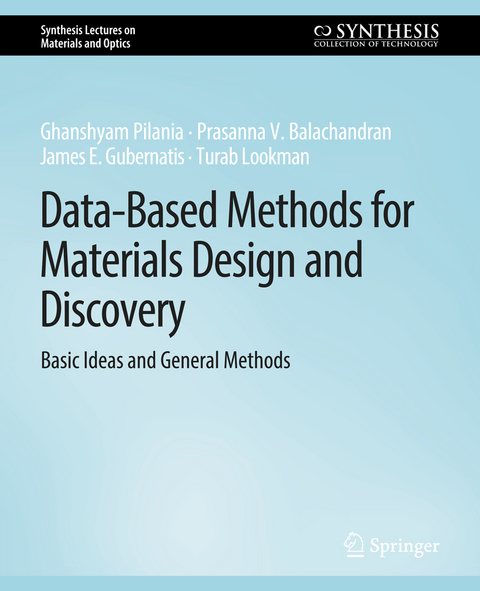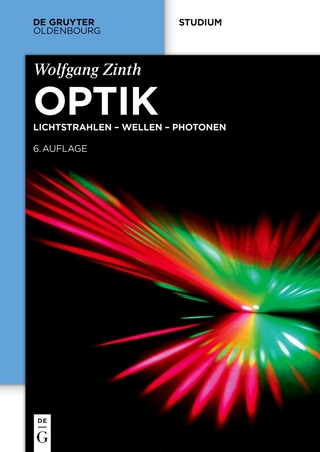
Data-Based Methods for Materials Design and Discovery
Springer International Publishing (Verlag)
9783031012556 (ISBN)
Ghanshyam Pilania is a scientist in the Materials Science and Technology Division at Los Alamos National Laboratory (LANL). He received a B.Tech. in Metallurgical and Materials Engineering from Indian Institute of Technology Roorkee, India in 2007, followed by a Ph.D. in Materials Science and Engineering from University of Connecticut, Storrs, in 2012. His four year postdoctoral work was supported by a LANL Directors' postdoctoral fellowship award and an Alexander von Humboldt postdoctoral fellowship at the Fritz Haber Institute of the Max Planck Society. His current research interests broadly include developing and applying high throughput electronic structure and atomistic methods to understand and design functional materials, with a particular focus on targeted materials design and discovery using materials informatics and machine learning based techniques.Prasanna V. Balachandran is currently an Assistant Professor with a joint appointment in the Department of Materials Science and Engineering and Department of Mechanical and Aerospace Engineering in University of Virginia (UVA). He earned his Bachelors' Degree in Metallurgical Engineering from Anna University, India in 2007 and a Ph.D. in Materials Science and Engineering from Iowa State University, in 2011. Prior to joining UVA in December 2017, he spent three and half years as a postdoctoral research associate in the Theoretical Division at Los Alamos National Laboratory (LANL), and two years as a postdoctoral research associate at Drexel University. His research interests are interdisciplinary spanning diverse areas such as crystal symmetry, first-principles-based density functional theory calculations, and information science methods for accelerating the design and discovery of new materials.James E. Gubernatis did his thesis work at Case Western Reserve University under the direction of P.L. Taylor and his post-doctoral work at Cornell University under the mentorship of J.A. Krumhansl. After his post-doctoral work, he joined the technical staff of the Los Alamos National Laboratory where he stayed until his recent retirement. During his career, his main research interests were Quantitative Nondestructive Evaluation using the scattering of elastic waves, Quantum Monte Carlo methods and their applications to interacting electron systems, and the application of machine learning methods to the design and discovery of materials. He is a past chair of the Division of Computational Physics of the American Physical Society and the Commission on Computational Physics of the International Union of Pure and Applied Physics. He is also a Fellow of the American Physical Society.Turab Lookman obtained his Ph.D. from Kings College, London and was Professor of Applied Mathematics at the University of Western Ontario, Canada until 1999. He was at Los Alamos National Laboratory for almost 20 years until 2019. His interests and expertise lie in aspects of Computational Materials Science, Condensed Matter Physics, including soft matter, and aspects of nonlinear dynamics and chaos theory. His focus since 2012 has been on the application of machine learning methods to materials design and discovery. Many of the methods discussed in this book were utilized in 2013-2016 in a highly successful project that led to the synthesis of new alloys and ceramics. He was honored as a Laboratory Fellow in 2017 and is a Fellow of the American Physical Society.
Preface.- Acknowledgments.- Introduction.- Materials Representations.- Learning with Large Databases.- Learning with Small Databases.- Multi-Objective Learning.- Multi-Fidelity Learning.- Some Closing Thoughts.- Authors' Biographies.
| Erscheinungsdatum | 06.06.2022 |
|---|---|
| Reihe/Serie | Synthesis Lectures on Materials and Optics |
| Zusatzinfo | XVI, 172 p. |
| Verlagsort | Cham |
| Sprache | englisch |
| Maße | 191 x 235 mm |
| Gewicht | 372 g |
| Themenwelt | Naturwissenschaften ► Physik / Astronomie ► Optik |
| Technik ► Maschinenbau | |
| ISBN-13 | 9783031012556 / 9783031012556 |
| Zustand | Neuware |
| Informationen gemäß Produktsicherheitsverordnung (GPSR) | |
| Haben Sie eine Frage zum Produkt? |
aus dem Bereich


